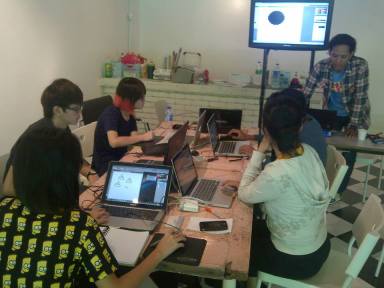
Oomeleo’s Pixel Art workshop starts off with a history lesson & ends with how you can create your own pixel art to tell your own story.
For the longest time, I’ve always asked myself; why the hell do I always gravitate towards producing an event or workshop?
Why can’t I be an artist?
Why do I find myself organizing another “social gathering” when I HATE doing management work?
I start my journey of rationalizing my actions by going back to the 2 observations I pointed out in the previous entry:
- Malaysian’s contact with technology ecosystem has always been as consumers of technology and not creators.
- Secondly, the Malaysian’s natural and persistent desire to “tame this beast” by means of hacking, piracy and re-ordering its functional structure.
It seems that I organize workshops to create a temporary spaces of gathering where people can come together and hack or re-order technological consumption for a renewed or more socially constructive purpose.
Hacking, in this sense, happens by re-purposing how we normally “use” the electronic goods. For reasons of resource accessibility, I carefully select everyday digital tools like a standard digital camera, digital audio recorder, a laptop equipped with basic software, a standard printer, and other mass produced digital goods; to be used as “learning” tools. I have thought about having a 3D printer, but until they become available to the masses; having one would just add to the “digital divide”.
Using them as learning tools, we are able democratize them from coveted consumer items consumed for its status symbol, to something more constructive and for the collective good. The workshop then tasks the participants to explore and think; “How can I create from this? How can I make original content that is my own?”
Quoting from Ryuichi Sakamoto; New York-based Japanese musician and composer;
“To me, computers are not that user-friendly in terms of interface. Compare for example a musical instrument and a computer in terms of interface, and the instrument wins hands down. In that it reacts instantly to sensory, tactile actions and conveys change in real time, a musical instrument is in my view a superior beast.”
“Compared to a musical instrument, computers are still in their infancy: An interview with Ryuichi Sakamoto, Creativity Seen and Unseen in Art and Technology: A Compendium of media art and performance from YCAM 2003-2008. p.41
Therefore, I also like to use a variety of tools and mediums. Of course, we all know that now, even the common smartphone has the multi-function ability to shoot, edit, record and distribute creations; all housed into one hardware. However, my reason for using different tools to carry out specific tasks is to expose the participants to the many interfaces and coordinating the mechanics of the tools. For example, when a person adjusts a camera’s lens or harnesses the camera onto a tripod. Or when a child needs to develop a steady hand to hold a microphone as she carefully listens to the sounds it picks up. These are all sensorial experiences heightened by the digital tool to learn about one’s immediate surroundings or locality.
Most important of all, these workshops must promote the spirit of working together. All the tools must be shared in a group. No one person has exclusive rights to any equipment.
I’m a real believer of shared learning. Thus, the final outcome of the workshop usually reflects this “shared” sense of purpose. It must be a product of different people working together towards one common goal. I think, how we order the usage of our tools can be used to encourage more collective (my biasness calls it “Asian” values) attitudes than individual ideals. I recall a conversation I had with my friend Andreas Siagian of Jogjakarta-based art-engineer collective, LIFEPATCH. I casually asked him about the work of LIFEPATCH and he corrected me when I described it as “D-I-Y” spirit.
“We’re are not about Do-It-Yourself. We are instead about ‘do-it-with-others’…DI-WOoo”
We both laughed at his attempt to acronym it on the spot.

Thanks for your intellectual assessment of human connection through the eyes of an artist/creative spirit. I plan to share with my students in the Fall semester.
Please do share. If there’s anything else you need from me, in terms of materials for your class, don’t hessitate to ask. We’re all about sharing here 🙂
Greetings Suzy,
Thanks. The Fall semester is here. I will sharing your information with my students, and I’ll keep you updated. Peace.
Homeless shelters and halfway houses Prisons and
prisons therefore on. Drug or alcohol centers, exclusive social welfare companies youth companies hire substance abuse consultants for their clients
or clients. drug abuse counseling is supposed to provide addicts some assistance
to find the best technique to defeat their challenge and change their negative actions with desirable ones.